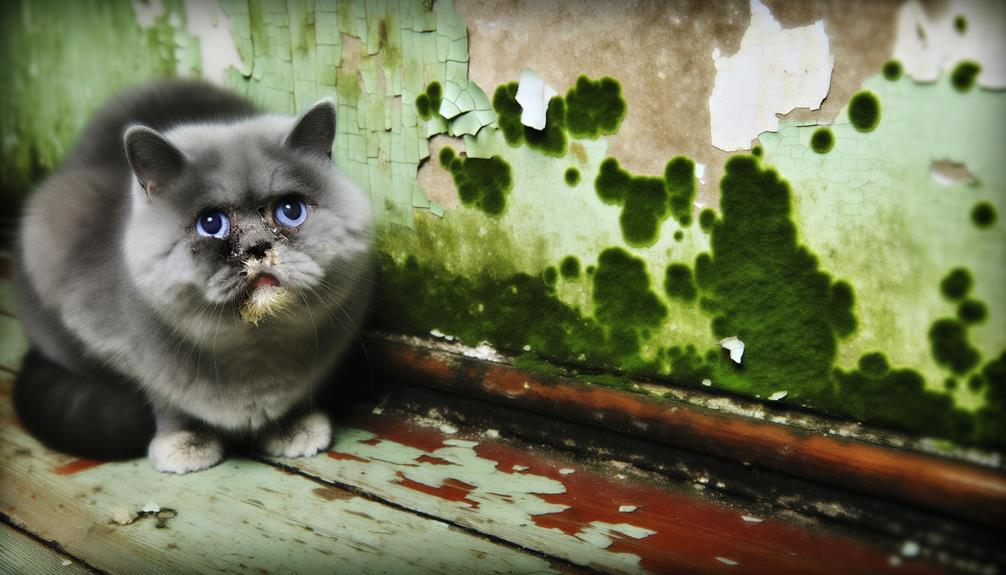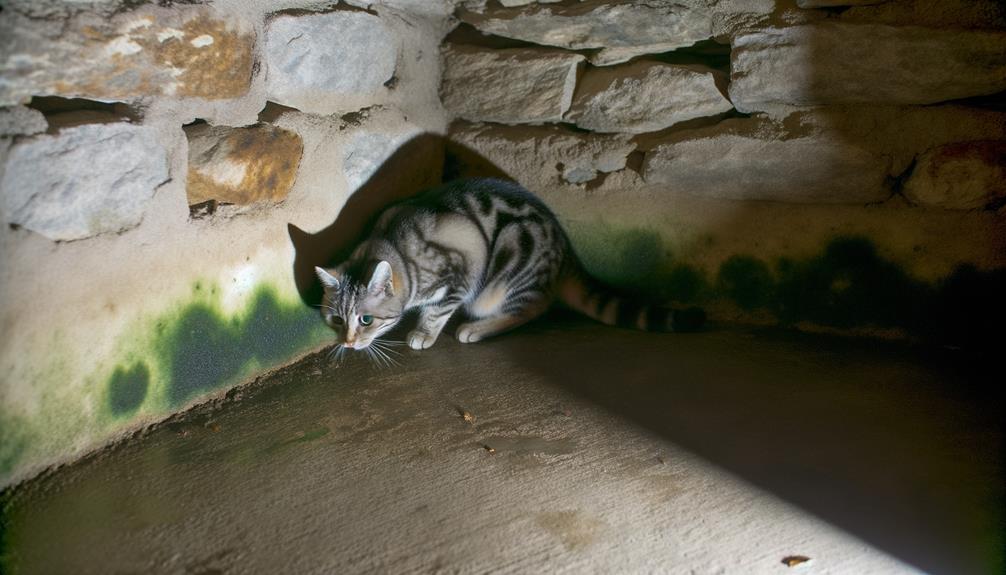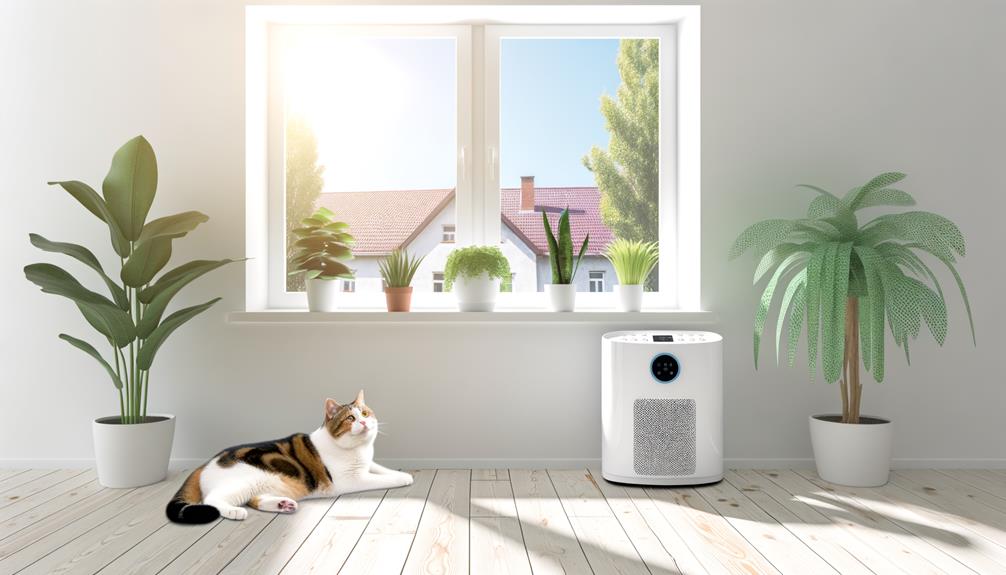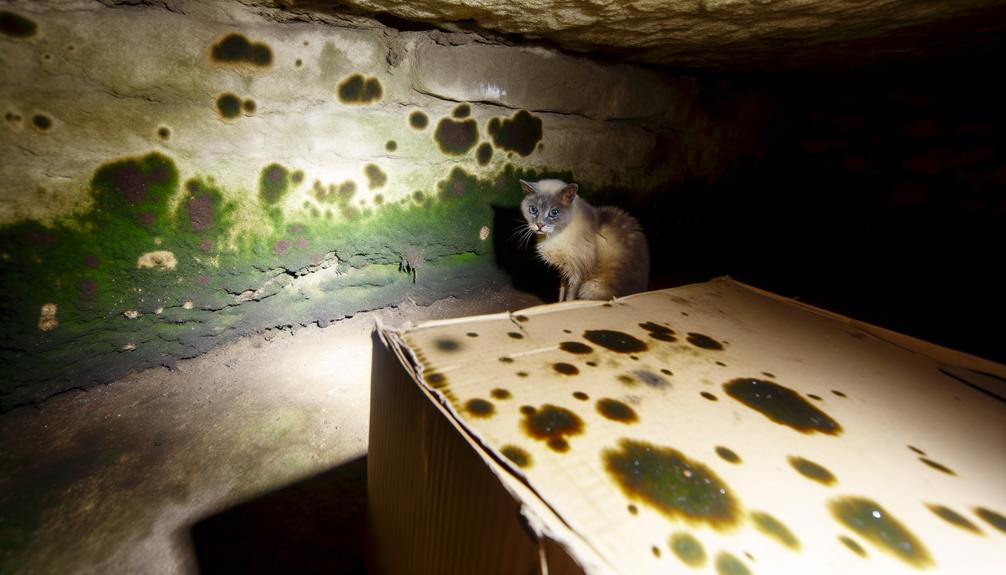You might be surprised to learn that your cat can get sick from mold exposure. Whether through inhalation, ingestion, or contact with contaminated surfaces, mold spores can trigger a range of health issues in your feline friend. Symptoms like excessive scratching, coughing, and lethargy are just the tip of the iceberg. But what types of mold are particularly harmful to cats, and how do you even diagnose such illnesses? Understanding these aspects can be essential in safeguarding your pet's health.
How Cats Get Exposed to Mold
When it comes to mold exposure, cats can encounter mold through various channels, each posing important health risks. Mold exposure primarily occurs through the inhalation of airborne spores. These spores are commonly found in damp environments like basements, bathrooms, or areas around windows and leaks. When your cat inhales these spores, it can lead to severe respiratory issues and allergic reactions, manifesting as sneezing, coughing, or even more severe breathing difficulties.
Another route of mold exposure is through ingestion. Cats may inadvertently consume moldy food or drink contaminated water, which can result in numerous health problems, including gastrointestinal distress. Moldy food is particularly hazardous, as it can harbor mycotoxins that are highly toxic to cats. Symptoms of ingestion might include vomiting, diarrhea, and lethargy, urging immediate veterinary attention.
Outdoor environments also present risks. If your cat enjoys exploring outside, it might come across decaying organic matter such as fallen leaves or rotten wood. These natural habitats are prime locations for mold spores to thrive. As your cat rummages through these materials, it can inhale or ingest mold, again leading to respiratory issues or gastrointestinal problems.
Even seemingly safe indoor areas can be deceptive. Items like bedding or toys, if not properly maintained and cleaned, can become breeding grounds for mold. Regular cleaning and inspection of these items are important to minimize the risk of mold exposure.
Ensuring your cat's environment is clean and dry is essential in preventing mold-related health issues. Awareness and proactive measures can greatly reduce the risks associated with mold exposure for your feline companion.
Symptoms of Mold Exposure in Cats

Mold exposure in cats isn't just about how they come into contact with mold; it's also about recognizing the symptoms that follow. Understanding the symptoms of mold exposure is essential for guaranteeing your cat's well-being. One of the most noticeable signs is excessive scratching and hair loss. Mold spores can irritate a cat's skin, leading to incessant scratching and, in severe cases, open sores and bald patches.
Respiratory issues are another significant concern. If your cat has been exposed to mold, you might notice coughing, sneezing, wheezing, or nasal discharge. These symptoms arise when mold spores are inhaled, causing irritation and inflammation in the respiratory tract. It's important to differentiate these signs from other respiratory health conditions, which can sometimes present similarly.
Behavioral changes are also common indicators of mold exposure. Increased hiding, lethargy, and a decreased appetite can signal that your cat is unwell. These behavioral changes often accompany physical symptoms and can be a response to the discomfort and stress caused by mold exposure.
Allergic reactions to mold can further complicate your cat's health. Excessive grooming, often a sign of skin irritation, can lead to secondary skin infections. This repetitive grooming behavior is an attempt to alleviate the discomfort caused by mold spores.
Prompt veterinary evaluation is vital if any of these symptoms of mold exposure are observed. Since these signs can mimic other health conditions, immediate attention guarantees accurate diagnosis and timely treatment. Acting quickly can make a significant difference in your cat's recovery and overall health.
Types of Mold Harmful to Cats

When considering types of mold harmful to cats, you should be aware of both allergenic and toxigenic varieties. Allergenic molds such as Cladosporium and Alternaria can cause allergic reactions, while toxigenic molds like Stachybotrys produce mycotoxins that pose severe health risks, including pulmonary hemorrhage. Recognizing these molds in damp environments is essential for protecting your cat's health.
Allergenic Mold Risks
Cats are often exposed to various environmental hazards, with allergenic mold being a frequent yet overlooked culprit. Mold exposure can lead to numerous health problems in cats, primarily allergic reactions and respiratory issues. Allergenic molds like Alternaria and Cladosporium are particularly harmful, triggering symptoms such as excessive itching, sneezing, and skin irritations.
Prolonged exposure can worsen, resulting in chronic respiratory issues that manifest as coughing, wheezing, and nasal discharge. Cats with pre-existing conditions or weakened immune systems are even more vulnerable, as allergenic mold can aggravate their health problems. Mold spores are easily inhaled, affecting your cat even in seemingly clean environments.
To keep your feline friend safe, consider these preventive measures:
- Regular Cleaning: Keep your home clean to minimize mold spores.
- Maintain Low Humidity: Use dehumidifiers and maintain proper ventilation to prevent the growth of mold.
- Monitor for Symptoms: Watch for signs of allergic reactions or respiratory issues in your cat.
Toxigenic Mold Dangers
While allergenic molds primarily cause allergic reactions and respiratory issues in cats, toxigenic molds pose even graver threats. Toxic molds, like Stachybotrys chartarum (black mold), Aspergillus, and Penicillium, produce mycotoxins that can severely affect your cat's health. These molds often thrive in damp or decaying environments, making basements, bathrooms, and kitchens common culprits.
When cats are exposed to these harmful molds, they can experience a range of symptoms. Excessive scratching, hair loss, and coughing are early signs of mold exposure. More alarming symptoms include lethargy and respiratory distress, indicating potential mycotoxin poisoning. Ingesting mold spores can also cause gastrointestinal damage, leading to vomiting and changes in appetite.
Prompt veterinary care is essential to prevent serious health consequences. If you suspect your cat has been exposed to toxic mold, seek immediate medical attention. Cleaning and maintaining dry living spaces can help prevent mold growth and keep your cats safe. Regular inspections and using dehumidifiers in prone areas can also be effective preventive measures. Remember, early intervention is key to safeguarding your cat's health from the dangers of toxigenic molds.
Diagnosing Mold-Related Illnesses

Diagnosing mold-related illnesses in your cat can be particularly challenging because symptoms often resemble other health issues. Your veterinarian will need to conduct a thorough examination and use key diagnostic methods, such as allergy testing and skin scrapings, to identify mold exposure. Timely veterinary intervention is essential for accurate diagnosis and effective treatment, helping to mitigate the health risks posed by mold.
Common Misdiagnosis Challenges
Due to the nonspecific nature of mold exposure symptoms in cats, reaching an accurate diagnosis presents significant challenges. Symptoms like excessive scratching, coughing, and lethargy can easily be mistaken for other conditions, such as allergies or infections. This overlap often leads to a common misdiagnosis among veterinarians. Understanding the signs of mold exposure is essential for cat owners and vets alike to avoid unnecessary treatments and prolonged discomfort for your pet.
Here are some common misdiagnosis challenges:
- Symptom Overlap: The symptoms of mold sickness in cats often mimic those of other feline health issues like respiratory infections or allergic reactions. This similarity makes it difficult to pinpoint mold as the culprit without extensive testing.
- Delayed Recognition: Many cat owners might not recognize the link between their pet's symptoms and potential mold exposure. This delay in consulting a veterinarian can complicate the diagnostic process and prolong suffering.
- Lack of Exposure History: Without a clear history of mold exposure, veterinarians may overlook mold-related health issues. This can lead to ineffective treatment plans as the primary cause remains unidentified.
Accurate diagnosis requires thorough veterinary examinations and sometimes even allergy testing to differentiate mold-related illnesses from other ailments.
Key Diagnostic Procedures
Accurate diagnosis of mold-related illnesses in cats hinges on a methodical approach that encompasses both clinical evaluation and specialized testing. When you're diagnosing your cat, the vet will start with a thorough examination to assess clinical signs like excessive itching, hair loss, or respiratory distress. These symptoms can indicate mold exposure or other health issues.
Allergy testing, including skin or blood tests, can be particularly insightful. These tests help determine if your cat is allergic to mold or other environmental allergens. It's a vital step in pinpointing the root cause of your cat's symptoms.
To rule out alternative skin conditions that might mimic mold exposure, vets often perform skin scrapings or cytology. Monitoring your cat's symptoms over time is fundamental, helping identify potential triggers and the overall impact of mold on their health. A detailed medical history and environmental assessment are essential in crafting an accurate diagnosis and effective treatment plan.
| Diagnostic Procedure | Purpose | Importance |
|---|---|---|
| Clinical Evaluation | Assess signs and symptoms | Initial step in diagnosing mold-related issues |
| Allergy Testing | Identify mold allergies | Pinpoints specific allergens |
| Skin Scrapings/Cytology | Rule out other skin conditions | Guarantees accurate diagnosis |
Veterinary Testing Methods
When it comes to identifying mold-related illnesses in cats, a variety of veterinary testing methods are employed to guarantee a thorough diagnosis. Mold can lead to numerous health problems in cats, making it vital to utilize extensive diagnostic procedures.
Here are three key methods used for diagnosing mold-related illnesses:
- Clinical Examination: A thorough clinical examination is essential. Symptoms like excessive grooming, sneezing, or skin lesions can indicate that your cat has been exposed to mold. The vet will look for these signs and assess their severity.
- Allergy Testing: To determine if your cat has developed an allergy to mold, vets often perform allergy testing. This can include skin tests or blood tests, which help identify specific environmental allergens affecting your cat's health.
- Skin Scrapings and Cytology: These tests help rule out other conditions that might present similarly to mold allergies. Since mold-related health problems often manifest as skin issues, these tests are invaluable for accurate diagnosis.
Additionally, fecal examinations can be conducted to check for gastrointestinal distress caused by mold ingestion. The vet will also monitor your cat's symptoms over time, along with a detailed medical history, to guarantee an effective diagnosis and management plan.
Treatment Options for Mold Exposure

Treating mold exposure in cats requires a multifaceted approach to address the various symptoms and prevent further complications. Your first step should be to seek immediate veterinary care if your cat exhibits severe symptoms. The veterinarian will likely focus on supportive care, targeting respiratory issues, dehydration, and gastrointestinal distress caused by mold ingestion. Oxygen therapy may be necessary if your cat is experiencing significant respiratory distress.
Supportive care forms the cornerstone of treatment for mold exposure. This may include intravenous fluids to combat dehydration and to flush out toxins. Addressing respiratory issues is essential; your vet might administer bronchodilators or antihistamines to ease breathing. In cases where respiratory distress is pronounced, oxygen therapy can be life-saving.
Antibiotics may be prescribed if your cat develops secondary infections from excessive scratching or skin lesions due to mold exposure. These medications will help prevent bacterial infections from complicating the primary issue. Additionally, glucocorticoids can offer short-term relief from allergic reactions, mitigating symptoms such as itching and inflammation.
Beyond these immediate treatment measures, identifying and removing the mold source from your cat's environment is vital for long-term recovery and health maintenance. Without eliminating the mold, your cat is at risk for recurrent exposure and subsequent health issues.
Preventing Mold Exposure in Cats

After addressing the immediate treatment needs for mold exposure, it's equally important to focus on preventing future incidents to safeguard your cat's health. Mold can lead to considerable health problems in cats, and taking proactive steps can help prevent mold-related issues.
To minimize mold growth and keep your pet safe, consider the following measures:
- Proper Food Storage: Store your cat's food in airtight containers and regularly check for mold or expiration dates. Contaminated food can lead to ingestion of harmful mold spores, causing various health issues.
- Routine Cleaning: Regularly clean and wash your cat's food and water bowls. This practice reduces the buildup of mold and other microorganisms, ensuring the feeding area remains hygienic and safe.
- Environmental Control: Maintain a clean living environment by inspecting areas prone to dampness, such as bathrooms and basements. Use dehumidifiers in high humidity areas to control moisture levels, making it less conducive for mold to thrive. Supervising your cat outdoors is also vital to prevent them from ingesting spoiled food or coming into contact with moldy materials like decaying plants or wood.
Implementing these steps will greatly reduce the risk of mold exposure and keep your pet healthier. It's important to keep your home environment clean and dry to prevent mold, as it can cause severe health problems for your cat. Regular vigilance and maintenance can go a long way in ensuring that your feline friend remains mold-free and healthy. By taking these preventive measures, you're providing a safer and more comfortable living space for your beloved pet.
